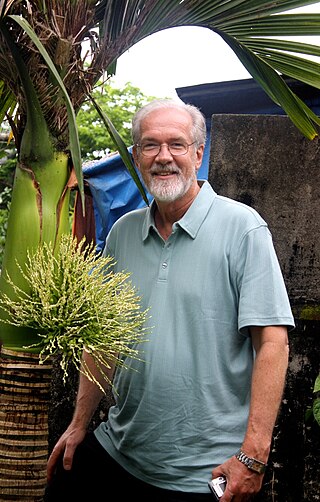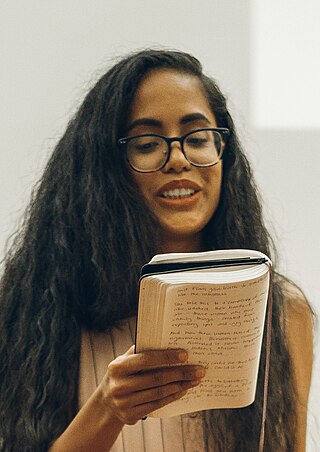The history of Guam starts with the early arrival around 2000 BC of Austronesian people known today as the Chamorro Peoples. The CHamorus then developed a "pre-contact" society, that was colonized by the Spanish in the 17th century. The present American rule of the island began with the 1898 Spanish–American War. Guam's history of colonialism is the longest among the Pacific islands.

Hone Peneamine Anatipa Te Pona Tūwhare was a noted Māori New Zealand poet. He is closely associated with The Catlins in the Southland region of New Zealand, where he lived for the latter part of his life.

The Chamorro people are the indigenous people of the Mariana Islands, politically divided between the United States territory of Guam and the encompassing Commonwealth of the Northern Mariana Islands in Micronesia. Today, significant Chamorro populations also exist in several U.S. states, including Hawaii, California, Washington, Texas, Tennessee, Oregon, and Nevada, all of which together are designated as Pacific Islander Americans according to the U.S. Census. According to the 2000 Census, about 64,590 people of Chamorro ancestry live in Guam and another 19,000 live in the Northern Marianas. Another 93,000 live outside the Marianas in Hawaii and the West Coast of the United States.

Albert Tuaopepe Wendt is a Samoan poet and writer who lives in New Zealand. He is one of the most influential writers in Oceania. His notable works include Sons for the Return Home, published in 1973, and Leaves of the Banyan Tree, published in 1979. As an academic he has taught at universities in Samoa, Fiji, Hawaii and New Zealand, and from 1988 to 2008 was the professor of New Zealand literature at the University of Auckland.

Paul Hoover is an American poet and editor born in Harrisonburg, Virginia.
Allison Adelle Hedge Coke is an American poet and editor. Her debut book, Dog Road Woman, won the American Book Award and was the first finalist of the Paterson Poetry Prize and Diane DeCora Award. Since then, she has written five more books and edited eight anthologies. She is known for addressing issues of culture, prejudice, rights, the environment, peace, violence, abuse, and labor in her poetry and other creative works.

Guam The following outline is provided as an overview of and topical guide to Guam:

John Puhiatau Pule is a Niuean artist, novelist and poet. The Queensland Art Gallery describes him as "one of the Pacific's most significant artists".

Donna Tusiata Avia is a New Zealand poet and children's author.

Jackie Craven is an American poet and author with a broad background in arts and the humanities.
Claudia Keelan is an American poet, writer, and professor. She received the Regents’ Creative Activities Award, at the University of Nevada, Los Vegas.
Samoan literature can be divided into oral and written literatures, in the Samoan language and in English or English translation, and is from the Samoa Islands of independent Samoa and American Samoa, and Samoan writers in diaspora. Samoan as a written language emerged after 1830 when Tahitian and English missionaries from the London Missionary Society, working with Samoan chiefly orators, developed a Latin script based Samoan written language. Before this, there were logologo and tatau but no phonetic written form.
Elizabeth Robinson is an American poet and professor, author of twelve collections of poetry, most recently Counterpart, "Three Novels" "Also Known A,", and The Orphan and Its Relations. Her work has appeared in Conjunctions, The Iowa Review, Colorado Review, the Denver Quarterly, Poetry Salzburg Review, and New American Writing. Her poems have been anthologized in "American Hybrid", "The Best of Fence", and Postmodern American Poetry With Avery Burns, Joseph Noble, Rusty Morrison, and Brian Strang, she co-edited 26 magazine. Starting in 2012, Robinson began editing a new literary periodical, Pallaksch. Pallaksch, with Steven Seidenberg. For 12 years, Robinson co-edited, with Colleen Lookingbill, the EtherDome Chapbook series which published chapbooks by emerging women poets. She co-edits Instance Press with Beth Anderson and Laura Sims. She graduated from Bard College, Brown University, and Pacific School of Religion. She moved from the Bay Area to Boulder, Colorado where she taught at the University of Colorado and at Naropa University. She has also taught at the Iowa Writers' Workshop and has twice served as the Hugo Fellow at the University of Montana.
The Chamorro Nation is a political movement seeking sovereignty for the island of Guam, founded by Angel Leon Guerrero Santos. The Chamorro Nation was formed on July 21, 1991, comprising numerous grassroots organizations which advocated for the protection of Chamorro land, culture, and political rights. As a political movement, the Chamorro Nation is recognized as a key turning point in changing Chamorro attitudes toward the United States and increasing the desire for Chamorro rights, particularly the return of lands seized from Chamorros by the US federal government.

Selina Tusitala Marsh is a New Zealand poet and academic, and was the New Zealand Poet Laureate for 2017–2019.

Kathy Jetn̄il-Kijiner is a poet and climate change activist from the Marshall Islands.

Lehua M. Taitano is a Chamoru poet, interdisciplinary artist, and educator. She is an indigenous person of the Mariana Islands, which are referred to as Laguås yan Gani in the Chamoru language.
Craig Morgan Teicher is an American author, poet and literary critic. His poetry collection, The Trembling Answers, won the Lenore Marshall Poetry Prize in 2018.
Brandy Nālani McDougall is a Kānaka Maoli author, poet, educator, literary activist, and associate professor at the University of Hawaiʻi at Mānoa.
Michael Lujan Bevacqua is a Chamorro scholar, activist, author, producer and editor. He currently lives in Mangilao, Guam and works at the Guam Museum as a curator. Bevacqua founded the first ever Chamorro Studies Program at the University of Guam in 2011, where he worked as a professor teaching the history of Guam and the Chamorro language for 10 years.











